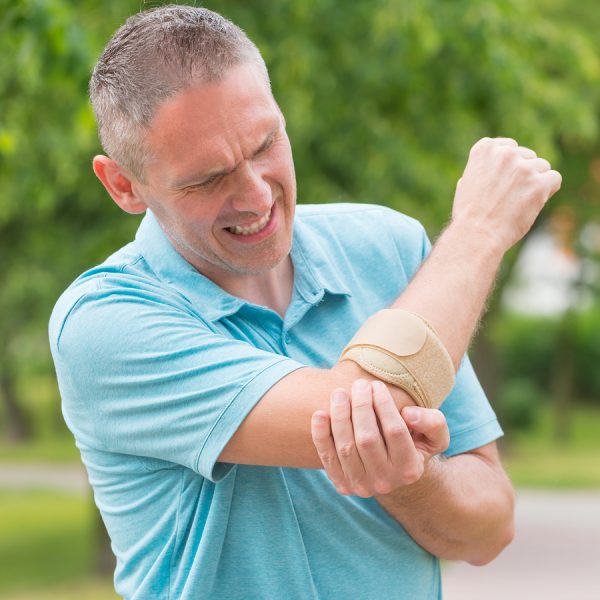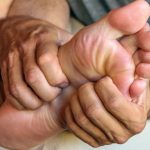When people come into my office with unexplained aches, pains or numbness in one elbow or another, they often describe their condition as “tennis elbow.”
And in many cases, they’ve looked this term up on the internet to set their own treatment schedule, only to find that it’s not working.
The reason is pretty simple. Not all aches and pains of the elbow are the same. So if you’re treating yourself for tennis elbow, you may be aggravating another condition that’s actually causing your elbow pain.
With this in mind, let’s take a look at some things that could be at the source of your elbow pain.
How to Identify Repetitive Strain Injuries
Tennis elbow is tendon inflammation (tendonitis) on the outside of the elbow caused by repetitious movements. An easy way to identify it is to place your palm on your stomach. This will place your elbow at about a 90-degree angle. The inflamed area will be the bony part at the outside of the elbow.
Golfers elbow is also a repetitive strain injury. The difference is that the pain, tenderness and inflammation are on the inner side of your elbow. The pain may also run down the inside of your forearm… the side that your pinky finger is on.
Both of these are caused by arm and wrist movements you make over and over again – from something as simple as the repetitive use of a screwdriver or scanning groceries to more intense activities like raking and painting.
Clearly, the first recommendation is to avoid those activities that are causing the problem to give your arm time to rest and recover. But that’s not always possible. In that case, it’s a good idea to use an elbow brace to prevent further strain and injury.
You can also alternate heat and ice for 15 to 20 minutes at a time, three to four times a day.
And here’s a cool trick.
My favorite way to ice is to fill one of those little Dixie cups with water. Then, stick it in the freezer. When it is frozen, you can tear off about a quarter inch of paper from the top, turn it upside down, and rub it around on your elbow.
Once the skin turns red, or if you feel an electric tingling down your arm, you’ll know it has been iced enough.
There are also a couple of exercises you can try.
For tennis elbow, you need stretch using extension exercises. For example, hold the affected arm straight out in front of you, palm facing the floor. Then, bend your hand at the wrist so your fingers all point to the ground. Place the palm of your other hand against the back of the affected hand and press it toward you. Hold the position for 30 seconds. Repeat three times.
Golfer’s elbow, on the other hand, needs flexion exercises. So you’ll do just the opposite. Hold your affected arm in front of you with the palm to the floor. Then, bend your hand at the wrist so all your fingers point toward the ceiling. Place your other hand in the center of the affected palm and press it toward you. Hold the position for 30 seconds. Repeat three times.
Just remember these key words whenever you flare up: rest, brace, heat, ice, stretch.
Doc, My Funny Bone Hurts!
Cubital tunnel syndrome is another cause of elbow pain. It occurs when you constantly hold your elbow in a flexed position of 90 degrees or more. This constant strain compresses the ulnar nerve that runs through your elbow.
It resembles the zing you get when you hit your “funny bone,” but it’s more consistent. (We actually don’t have a funny bone… what we’re really hitting is this nerve.) When this nerve is constantly compressed, it causes pain, numbness and tingling that can radiate all the way down into your pinky and ring fingers.
Simple things like driving with your elbow propped on the window or console can set it off. Typing on a computer keyboard with your elbows flexed for long periods of time or leaning your elbows on your desk regularly can bring it on, too. Even sleep can aggravate it, especially if you sleep with your arms bent.
During the day, I recommend wearing a padded elbow brace. This helps keep your elbow at a straighter angle and reminds you not to lean on it. (If you do occasionally lean on it, the padding helps reduce nerve compression.)
Then, when you’re ready for bed, remove the brace and wrap a towel around your elbow to keep it straight while sleeping.
Bursitis is also caused by leaning on your elbow for long periods of time. This irritates the bursa sacs that cushion and lubricate the bony tip of your elbow. But unlike cubital tunnel syndrome, swelling is often the first symptom. This swelling causes the bursa to stretch and become painful.
Rest, elbow pads or braces, ice and heat, and resisting the urge to rest your elbow on hard surfaces can all help speed up your recovery.
However, I do have a word of caution when it comes to bursitis. If your elbow becomes hot, red and painful, it may be caused by an infection in the bursa sacs. In this case, it’s very important that you seek immediate medical attention.




